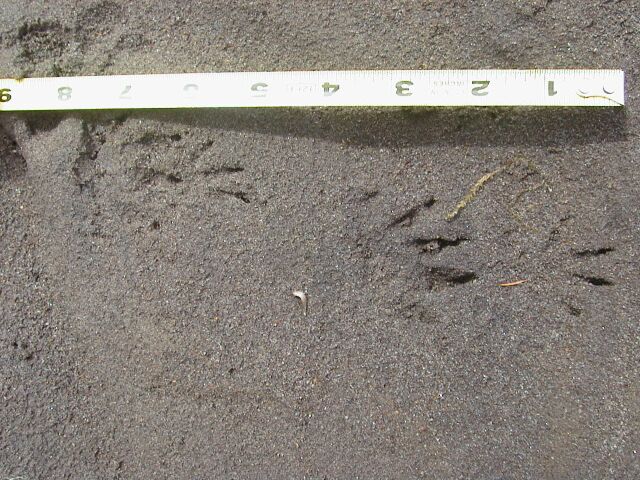 Photo by Dennis Deck
Photo by Dennis Deck
 Photo by Dennis Deck
Photo by Dennis Deck
Who is this little creature? [ View Answer ]
This muskrat hauled out of the water in a quiet stretch of the Sandy River in Oxbow Park
one morning in April. At first the tracks seemed out of place on a fast moving stream like
the Sandy but this wasn't the first time I had seen evidence of this aquatic mammal.
On a visit to the park the previous fall, I saw cut reeds in the water downstream of this
spot but was assured by a local naturalist that muskrat were not found in the park.
However, on other visits to the area I found further evidence of muskrat and one day in
July I was able to observe a muskrat upstream of this location, swimming along the bank.
Although muskrat are more typically seen around cattail marshes and lakes, apparently they can
live in fairly swift moving water. With a bit of research I have found other references to muskrats
living in moving water.
Answer
 The front foot has 4 toes. A close look at the hind track reveals 5 toes (though the first is
faint and offset to the inside). That pattern identifies this animal as a member of the rodent order.
The size of the track eliminates squirrels and anything smaller. The proximity to water is
another important clue but this is much smaller than a beaver.
The front foot has 4 toes. A close look at the hind track reveals 5 toes (though the first is
faint and offset to the inside). That pattern identifies this animal as a member of the rodent order.
The size of the track eliminates squirrels and anything smaller. The proximity to water is
another important clue but this is much smaller than a beaver.  For Oregonians in the Portland area, the cattail pond at Fernhill wetlands (south of the Forest Grove
sewage plant) is an excellent place to observe muskrat at work and play.
For Oregonians in the Portland area, the cattail pond at Fernhill wetlands (south of the Forest Grove
sewage plant) is an excellent place to observe muskrat at work and play.